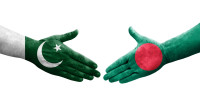Opinion
Joining hands
Saarc leaders should work together to ensure wellbeing of their citizens going abroad as migrant workers
Renu Adhikari
The Nepal government will be hosting the South Asian Association for Regional Cooperation (Saarc) representatives to discuss a common approach to migration in the region on May 3 and 4. This is an important step towards fulfilling the commitment made by the South Asian heads of state in November 2014 in Kathmandu during the 18th Saarc Summit, which had resulted in a declaration containing article 21 on labour migration and article 19 on prevention of trafficking. Nepal subsequently drafted a plan of action to implement these commitments, which will be discussed and finalised at the upcoming meeting, before being adopted at the 19th Saarc Summit in Islamabad later this year.
While the Nepal government should be applauded for its initiative, the Saarc leaders should now internalise the need to work together as a group of sending countries to ensure the protection and wellbeing of their citizens going abroad as migrant workers. The upcoming meeting provides an opportunity to transform this commitment into action by setting up a Saarc infrastructure to address crucial issues in labour migration and agree on a number of thematic issues to be tackled as part of its work plan.
Important yet unacknowledged
An estimated two million people migrate annually from South Asia for work. The trend has been increasing every year, as has the share of female migrants. Initially the Gulf was primarily dominated by Sri Lankan and Indian women migrant workers, but changes in demography and increased demand in domestic work in these countries have triggered growing migration among Nepali and Bangladeshi women in recent years. Remittances sent by migrant workers contribute significantly to economic growth and revenue of South Asian countries. As documented by the World Bank, India roughly receives $70 billion annually, Pakistan $15 billion, and Bangladesh $14 billion. In the case of Nepal, remittances account for 29 percent of its GDP. Remittances were key in sustaining Nepal’s economy during the country’s 12-year-long political conflict, and have been observed to play an indispensable role in recovery after last year’s earthquake.
Meanwhile in the Gulf, it is the South Asian migrant workers who have built the futuristic towers of Burj Khalifa in Dubai and Abraj Al-Bait in Mecca; it is they who have erected the glittering metropolises of Dubai and Doha. But they are made to work under harsh conditions; many of them are underpaid or have to work for long hours without overtime pay. Women migrant workers from this region have been contributing to the empowerment of women in Lebanon, Kuwait, Saudi Arabia, the United Arab Emirates and other countries by taking care of their prescribed gender roles as domestic workers in their homes, thus enabling them to pursue higher careers in their societies and uplifting the socio-economic status of their families.
And yet, their enormous contributions both at home and abroad are not adequately recognised or welcomed. Their pain and pleas are not acknowledged. They continue to get beaten, abused, and kept in captivity, made to work in unsafe conditions and even tortured or sold into slavery. As a result, a country like Nepal receives an average of three dead bodies per day. Similar instances are witnessed in other South Asian countries.
Statelessness among children born to migrant workers is another grave issue. “I have been married to an Indian Punjabi man for the last 20 years. We have four children. The oldest is fourteen and youngest is three. Both of us want to return home but cannot do so, as our children do not have any papers. They cannot even go to school. They are not recognised by any government,’’ laments a 45-year-old Sri Lankan migrant worker I met at a shelter for migrant workers in Beirut. She is trapped in an uncertain situation without a future for her children.
Her story is not an exception. Equally well-known and perhaps more widely publicised have been the high levels of suicide among Nepali women migrant workers in Lebanon, the situation of stranded migrants in Libya, Syria and other countries, and the suffering of Nepalis in Qatar working to build stadiums for the 2022 Fifa World Cup .
Right way to go
It is now time for the South Asian governments to recognise this situation. They have to show the solidarity with their citizens who have been suffering for years in foreign lands and come together through the Saarc to protect them. The coming months present the governments with a unique opportunity to rise to the occasion, starting with the Saarc meeting this week.
The draft plan of action, proposed after long advocacy from sensitive government representatives, alongside committed civil society groups, has given hope to desperate migrant workers and thousands of innocent victims of trafficking from this region. It envisions the establishment of a formal body to encourage cooperation on migration, drafting a Saarc declaration on the rights of migrant workers, establishing a regional standard contract and minimum wage, ensuring ethical recruitment, integrating migration into the post-2030 development strategies, and improving access to justice. An endorsement of this plan, along with the creation of a Saarc Technical Committee on Labour Migration to take forward the agenda, would be indispensable steps towards the realisation of this hope. The South Asian governments should be encouraged to join hands and follow in the footsteps of their workers. There is a lot of work to be done; let’s do it together.
Adhikari is the chairperson of Women’s Rehabilitation Center (Worec) Nepal and executive board member of Migrant Forum in Asia




 17.12°C Kathmandu
17.12°C Kathmandu










